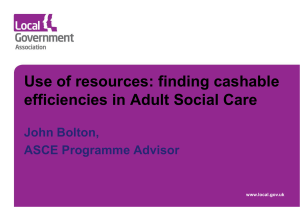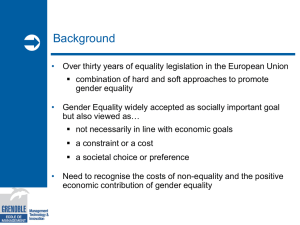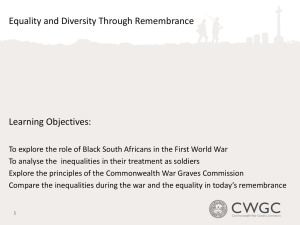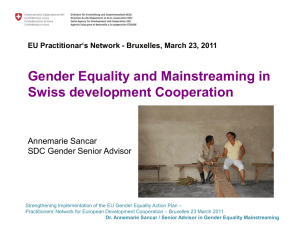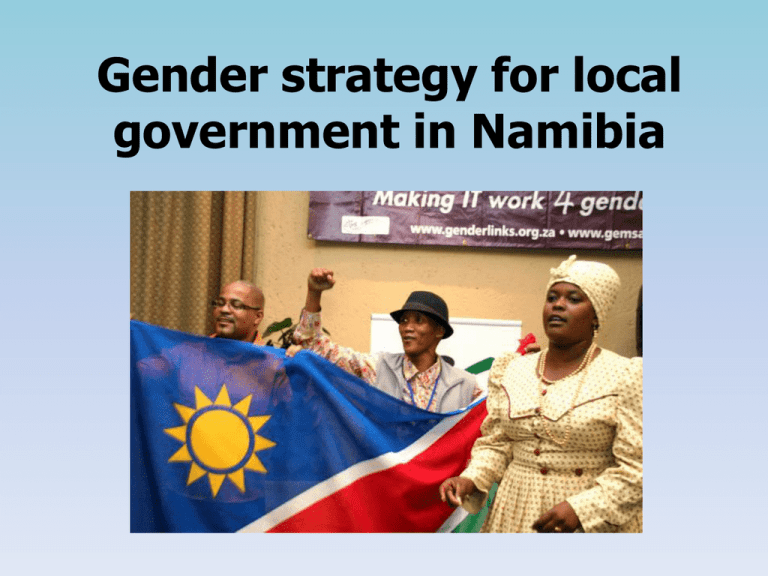
Gender strategy for local
government in Namibia
The aim of a gender strategy
• To effect government
commitments to
gender equality at the
local level.
• Practical steps for
ensuring that gender
is mainstreamed in
and through the
government.
Why gender?
• What is gender?
- the different societal expectations, norms
and values ascribed to women and
men/boys and girls in a society.
• What is gender stereotyping?
- the way that society expects women and
men to behave and the roles they are
expected to play.
Women and men in Namibia
• Population: 51%
women, 49% men.
35% urban, 65%
rural.
• Gender equality is
enshrined in the
Constitution but does
not translate to
equality on the
ground.
Women and men in Namibia
• 56% of men are employed
compared to 41% women.
• 42% councillors in local
government are women but
only 27% members of
parliament are women.
• 28% increase in incidences
of rape and gender based
violence.
• HIV/AIDS means many
fragile gains women have
made are being reversed.
Why gender?
• What is gender equality and equity?
- ensuring equal opportunities for women
and men to enjoy their human rights.
- more than equality of opportunity, it is
about equality of outcome and results.
Commitments to gender
equality and equity
•
International and regional
- Southern African
Development Community
Protocol on Gender and
Development 2008, ratified by
Namibia
- International Union of Local
Authorities (IULA) Worldwide
Declaration on Women in Local
Government
- CEDAW (Convention on the
Elimination of All Forms of
Discrimination Against Women)
- Protocol to the African
Charter for Human and People’s
Rights of Women in Africa
•
National
- The Constitution: outlaws
discrimination based on sex, gives
women and men equal rights as
citizens.
- Laws that provide for
affirmative action: Local
Authorities Act 23 of 1992,
Traditional Authorities Act of 1995,
Affirmative Action (Employment)
Act of 1998
- The Labour Act 6 of 1992
- National Gender Policy
updated in 2010 and the
National Gender Plan of
Action (2010 – 2015)
What is gender mainstreaming?
• To assess the
implications for women
and men of any
planned action.
• To make the concerns
and experiences of
women and men an
integral part of policies
and programmes.
• The ultimate goal of
gender mainstreaming
is to achieve gender
equality.
Practical and strategic gender
needs
• Practical needs
- related to daily
needs and activities
• Strategic needs
- changing the
relationships, roles
and responsibilities of
men and women
Gender mainstreaming meets practical
and strategic gender needs.
Gender management system
• Tools and structures
in place to make sure
that gender is
mainstreamed in
policy formulation,
programming and in
all areas of
organisational work.
Planning
• Make sure that those marginalised voices
form part of the overall outcome of the
envisaged activities.
• Strategy:
- women and men to be consulted prior to
the drawing up of local government plans
Gender structures
• Headed by the Ministry of Gender Equality
and Child Welfare, some ministries and
local government have gender focal points
or units.
• Strategy:
- each local authority should have a
gender coordinator who is gender aware
Gender budgeting
• A tool that looks into the needs of various
targeted groups (for example, women).
How does the budget relate to their
needs?
• Strategy:
- women and men to participate equally in
public consultations on planning and
budgets
Centres of Excellence for
Mainstreaming Gender in Local
Government
• Empowers local
authorities in Namibia
to engender their
policies, programmes
and guidelines.
• So far, COEs have
been implemented in
10 Namibian councils.
Stages of COEs
• Stage 1: Meetings with
management teams of
councils
• Stage 2: Situational
analysis
• Stage 3: Council level
policy and
implementation
workshops
• Stage 4V: Community
mobilisation village level
meetings on the SADC
Protocol
Stages of COEs
• Stage 5: Capacity building
through on the job
training
• Stage 6: Application of
skills in running major
campaigns
• Stage 7: Gender and local
economic development
• Stage 8: Gender and
sustainable development
• Summit: Best practices,
case studies, lessons
learned
Cascading the COEs
• Cascading is about
comparing notes,
sharing experiences
within local
governance
structures.
• 10 councils have
become COEs and
this has to be
replicated to others
across the country.
Ways to cascade COEs
1. Train gender champions (individuals or
structures) in the current COE councils as
trainers. This ensures continuous support,
ownership and sustainability.
2. Peer learning among the councils: it is
important for the councils to learn from each
other, use each other as resources and
share skills.
3. Big sister programme: cities and towns
working with village councils to assist them
in becoming COEs.
Group work
• Identify the clusters
• Councils to work in
clusters








